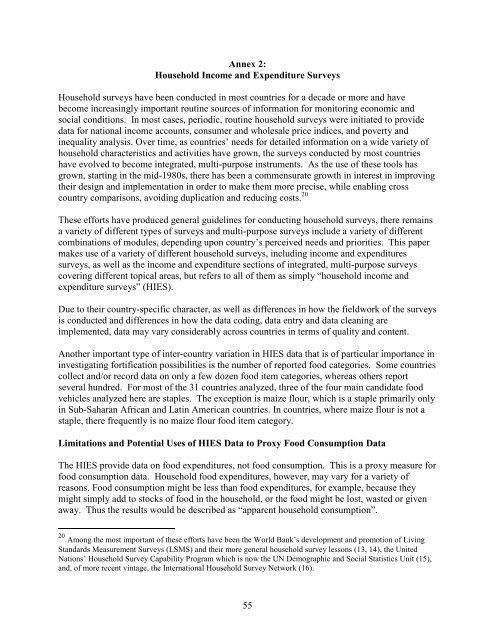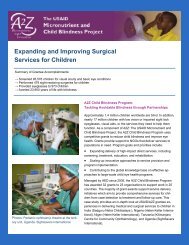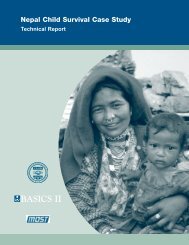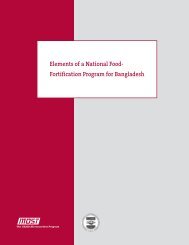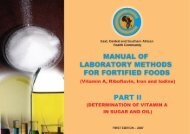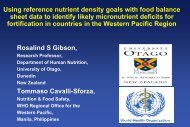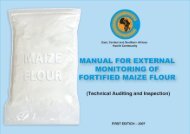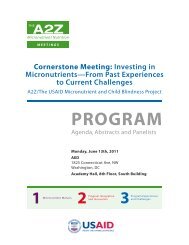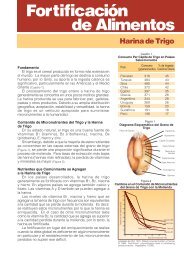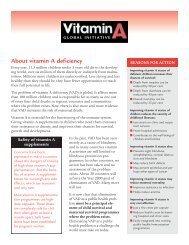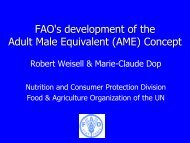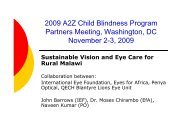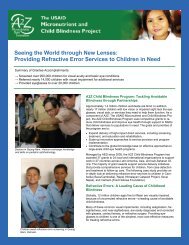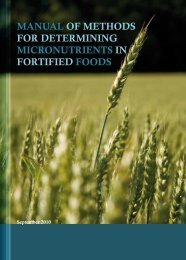Fortification of Vegetable oil and Sugar with Vitamin A in Uganda
Fortification of Vegetable oil and Sugar with Vitamin A in Uganda
Fortification of Vegetable oil and Sugar with Vitamin A in Uganda
You also want an ePaper? Increase the reach of your titles
YUMPU automatically turns print PDFs into web optimized ePapers that Google loves.
Annex 2:<br />
Household Income <strong>and</strong> Expenditure Surveys<br />
Household surveys have been conducted <strong>in</strong> most countries for a decade or more <strong>and</strong> have<br />
become <strong>in</strong>creas<strong>in</strong>gly important rout<strong>in</strong>e sources <strong>of</strong> <strong>in</strong>formation for monitor<strong>in</strong>g economic <strong>and</strong><br />
social conditions. In most cases, periodic, rout<strong>in</strong>e household surveys were <strong>in</strong>itiated to provide<br />
data for national <strong>in</strong>come accounts, consumer <strong>and</strong> wholesale price <strong>in</strong>dices, <strong>and</strong> poverty <strong>and</strong><br />
<strong>in</strong>equality analysis. Over time, as countries’ needs for detailed <strong>in</strong>formation on a wide variety <strong>of</strong><br />
household characteristics <strong>and</strong> activities have grown, the surveys conducted by most countries<br />
have evolved to become <strong>in</strong>tegrated, multi-purpose <strong>in</strong>struments. As the use <strong>of</strong> these tools has<br />
grown, start<strong>in</strong>g <strong>in</strong> the mid-1980s, there has been a commensurate growth <strong>in</strong> <strong>in</strong>terest <strong>in</strong> improv<strong>in</strong>g<br />
their design <strong>and</strong> implementation <strong>in</strong> order to make them more precise, while enabl<strong>in</strong>g cross<br />
country comparisons, avoid<strong>in</strong>g duplication <strong>and</strong> reduc<strong>in</strong>g costs. 20<br />
These efforts have produced general guidel<strong>in</strong>es for conduct<strong>in</strong>g household surveys, there rema<strong>in</strong>s<br />
a variety <strong>of</strong> different types <strong>of</strong> surveys <strong>and</strong> multi-purpose surveys <strong>in</strong>clude a variety <strong>of</strong> different<br />
comb<strong>in</strong>ations <strong>of</strong> modules, depend<strong>in</strong>g upon country’s perceived needs <strong>and</strong> priorities. This paper<br />
makes use <strong>of</strong> a variety <strong>of</strong> different household surveys, <strong>in</strong>clud<strong>in</strong>g <strong>in</strong>come <strong>and</strong> expenditures<br />
surveys, as well as the <strong>in</strong>come <strong>and</strong> expenditure sections <strong>of</strong> <strong>in</strong>tegrated, multi-purpose surveys<br />
cover<strong>in</strong>g different topical areas, but refers to all <strong>of</strong> them as simply “household <strong>in</strong>come <strong>and</strong><br />
expenditure surveys” (HIES).<br />
Due to their country-specific character, as well as differences <strong>in</strong> how the fieldwork <strong>of</strong> the surveys<br />
is conducted <strong>and</strong> differences <strong>in</strong> how the data cod<strong>in</strong>g, data entry <strong>and</strong> data clean<strong>in</strong>g are<br />
implemented, data may vary considerably across countries <strong>in</strong> terms <strong>of</strong> quality <strong>and</strong> content.<br />
Another important type <strong>of</strong> <strong>in</strong>ter-country variation <strong>in</strong> HIES data that is <strong>of</strong> particular importance <strong>in</strong><br />
<strong>in</strong>vestigat<strong>in</strong>g fortification possibilities is the number <strong>of</strong> reported food categories. Some countries<br />
collect <strong>and</strong>/or record data on only a few dozen food item categories, whereas others report<br />
several hundred. For most <strong>of</strong> the 31 countries analyzed, three <strong>of</strong> the four ma<strong>in</strong> c<strong>and</strong>idate food<br />
vehicles analyzed here are staples. The exception is maize flour, which is a staple primarily only<br />
<strong>in</strong> Sub-Saharan African <strong>and</strong> Lat<strong>in</strong> American countries. In countries, where maize flour is not a<br />
staple, there frequently is no maize flour food item category.<br />
Limitations <strong>and</strong> Potential Uses <strong>of</strong> HIES Data to Proxy Food Consumption Data<br />
The HIES provide data on food expenditures, not food consumption. This is a proxy measure for<br />
food consumption data. Household food expenditures, however, may vary for a variety <strong>of</strong><br />
reasons. Food consumption might be less than food expenditures, for example, because they<br />
might simply add to stocks <strong>of</strong> food <strong>in</strong> the household, or the food might be lost, wasted or given<br />
away. Thus the results would be described as “apparent household consumption”.<br />
20 Among the most important <strong>of</strong> these efforts have been the World Bank’s development <strong>and</strong> promotion <strong>of</strong> Liv<strong>in</strong>g<br />
St<strong>and</strong>ards Measurement Surveys (LSMS) <strong>and</strong> their more general household survey lessons (13, 14), the United<br />
Nations’ Household Survey Capability Program which is now the UN Demographic <strong>and</strong> Social Statistics Unit (15),<br />
<strong>and</strong>, <strong>of</strong> more recent v<strong>in</strong>tage, the International Household Survey Network (16).<br />
55


